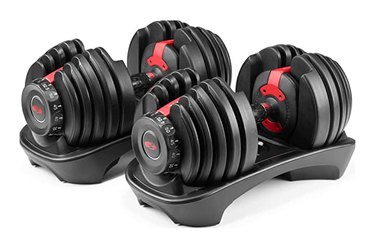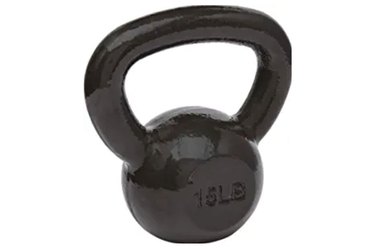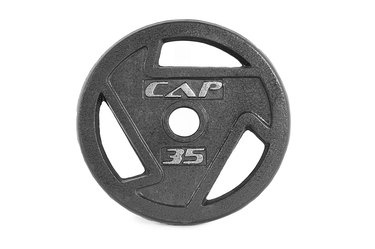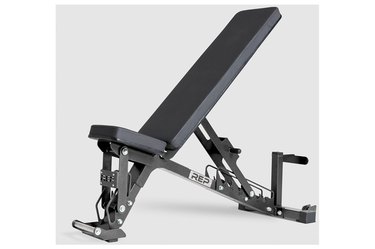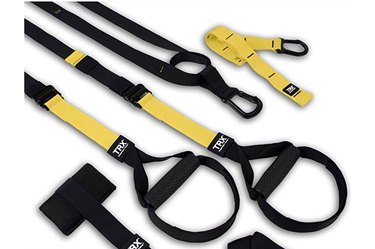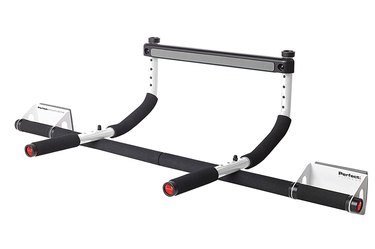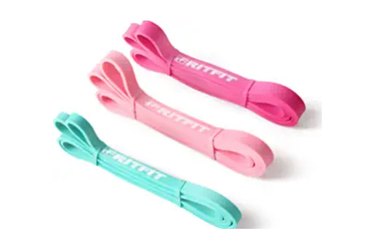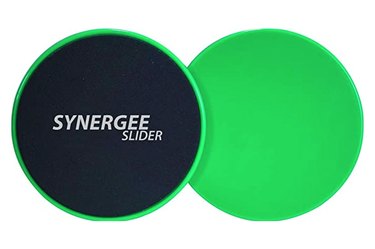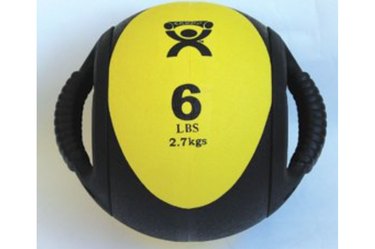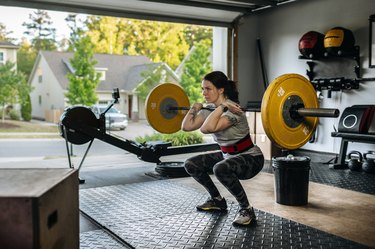
For some, spending an hour or two at the gym each day simply isn't feasible. Fortunately, it's absolutely possible to meet your fitness goals at home — especially if you're willing to invest in some strength-training gear, certified strength and conditioning specialist Mia Nikolajev, CSCS, tells LIVESTRONG.com.
Here, Nikolajev and four other trainers break down the pros and cons of dumbbells, kettlebells, barbells, TRX bands and much more to help you figure out what weight-lifting equipment is best suited to your personal goals (and budget!).
Related Reading
Barbells
"Barbells are the single best piece of equipment you can get for improving strength and muscle mass from head to toe," Nikolajev says. That's because barbells allow you to do full-body compound movements like squats, deadlifts and overhead presses.
Compound exercises are one of the most effective ways to build strength because they work multiple muscle groups at once. But barbells aren't just great for compound movements. They can also be used for isolation exercises, such as triceps extensions, biceps curls and barbell roll-outs.
The only downside to barbells is that all movements are bilateral, meaning you can't do exercises that isolate one side of the body.
"You don't have the freedom to do unilateral movements like you can with dumbbells and kettlebells," Nikolajev says.
For example, you can't do a shoulder press using just your right side with a barbell the way you could with a dumbbell to work on single-sided strength.
While there are many different types of barbells, including trap bars, EZ bars and hex bars, Nikolajev says, "if you can only get one, get a standard Olympic barbell." Unlike regular barbells, Olympic barbells have rotating sleeves, which allow you to do more explosive, technical movements with ease.
Is a Barbell Right for You?
Pro | Con |
|---|---|
Effective tool for strength and muscle gains | Can only be used for bilateral exercises and requires plates |
Shop Our Favorite Barbells
- The Ohio Bar ($350, RogueFitness.com)
- Basic Barbell ($119.99, RepFitness.com)
- The Bella Bar ($295, RogueFitness.com)
Dumbbells
"Dumbbells are a fantastic fitness tool because there are no limitations to what you can use them for," Kristian Flores, CSCS, tells LIVESTRONG.com. "You can use them to train for muscle growth, maximum strength, explosive power, Olympic weight-lifting movements, core training, conditioning, corrective exercises, weight loss — you name it, the list goes on forever."
The biggest perk of using dumbbells is barbells' downfall: They can be used for unilateral movements. "Dumbbells force each side to work individually, which enhances the use of the stabilizing muscles and core," Flores says.
While dumbbells are available in a wide range of weights, they aren't ideal for more advanced athletes who do much heavier lifts and are better off with a barbell with weight plates.
If you're looking for a space-efficient way to incorporate dumbbells into your home gym, consider adjustable options, where you can turn a dial to change the weight. Most adjustable dumbbells allow you to change the weight in increments of 5 to 10 pounds.
Are Dumbbells Right for You?
Pro | Con |
|---|---|
Allow for a wide variety of exercises | May not provide enough weight for advanced lifters |
Shop Our Favorite Dumbbells
- Bowflex SelectTech 552 Adjustable Dumbbells ($429, Amazon.com)
- Tru Grit Fitness Rubber Hex Dumbbells ($135, Amazon.com)
- POWERBLOCK Sport 24 Adjustable Dumbbells ($305.98, Amazon.com)
Kettlebells
"If you are one of the millions of people who sit a lot during the day, kettlebells might be perfect for you," Flores says.
When you sit all day, your hamstrings and glutes become stiff — and kettlebells are great for a variety of hip hinge exercises, including kettlebell swings, deadlifts, good mornings and single-arm cleans.
These movements not only target the hip flexors, glutes and hamstrings, but they may also help counteract some of the negative effects of a sedentary lifestyle.
Plus, because of the way the kettlebell is designed — a heavy metal ball with a thick handle — it can challenge your strength in different ways than dumbbells and barbells, where the weight is evenly distributed on both sides.
Just like dumbbells, there are adjustable kettlebells available to help you save room in your home and still reap the benefits of this multi-functional tool.
Are Kettlebells Right for You?
Pro | Con |
|---|---|
Great tool for total-body strengthening with functional exercises | Best for advanced lifters who can do functional movements safely |
Shop Our Favorite Kettlebells
- Rogue Kettlebell ($30, RogueFitness.com)
- Amazon Basics Cast Iron Kettlebell Weight ($17, Amazon.com)
- First Place Gravity Kettlebell ($16, PerformBetter.com)
Weight Plates
No doubt, you'll get more bang for your weight plate buck if you also invest in a barbell. But according to Philadelphia-based athletic trainer Mike Watkins, LAT, ATC, founder of Festive Fitness, you can probably do more exercises with weight plates alone than you might guess.
These exercises include lateral shoulder raises, front shoulder raises, weighted wall-sits, deadlifts, chest presses and Russian twists.
There's also Watkins' personal favorite: seated steering wheels. "Holding your arms straight out in front of you and rotating your arms side to side, like a steering wheel, from a wall-sit position will work almost every muscle in your body," he says.
Some weight plates are designed with a lip around the edge or have a special texture that makes them easier to grip for these types of exercises.
As creative as you can get with them, though, the obvious caveat of weight plates is that they are most functional when bought in combination with a barbell.
Are Weight Plates Right for You?
Pro | Con |
|---|---|
Budget-friendly, space-friendly and great for accessory work | Most beneficial in tandem with a barbell |
Shop Our Favorite Weight Plates
- Cap Olympic Grip Weight Plate Collection ($50, Amazon.com)
- BalanceFrom Cast Iron Olympic 2-Inch Weight Plate ($62.99, Amazon.com)
- Sporzon! Cast Iron Plate Weight Plate for Strength Training ($17, Amazon.com)
Weight Benches
Weight benches are famous for their ability to facilitate a chest pump. As CJ Hammond, CPT, owner of health and wellness brand and personal training business Fit Legend, puts it: "Benches are great for certain aesthetic goals."
But newsflash: Benches can be used for all sorts of other exercises, including triceps dips, step-ups, single-leg squats and more.
"While benches are often ignored as lower-body equipment, they can be used for upper- and lower-body work," he says. (Of course, a regular bench or stairs can work, too.)
The average weight bench costs $100 or more, so consider your budget carefully before you buy one. What's ultimately going to make your investment worthwhile is if you also get a set of dumbbells and/or a barbell to build muscle mass or strength.
Are Weight Benches Right for You?
Pro | Con |
|---|---|
Budget-friendly and helpful for all kinds of workouts | Most useful when you have additional weights, like dumbbells or a barbell |
Shop Our Favorite Weight Benches
- AB-5200 Adjustable Weight Bench ($499.99, RepFitness.com)
- Rogue Monster Westside Bench ($1,500, RogueFitness.com)
- Sporzon Multifunctional Workout Station Adjustable Olympic Workout Bench With Squat Rack ($138.37, Amazon.com)
TRX
This popular brand of suspension systems is a favorite among fitness influencers and trainers, but they're the perfect addition to anyone's home gym.
"They're especially great for folks looking to increase overall strength [who] don't have the space or budget for weights," Watkins says.
Short for "total-body resistance," TRX bands are a system of straps and handles that can be hung up on a door, tree or ceiling for suspension training.
"The straps allow you to do body-weight movements against gravity," Watkins says.
By changing the angle of your body in relation to the mount point, you're able to alter exactly how much gravity you're working against, and therefore, how challenging the movement is. So suspension exercises — such as push-ups, lunges, chest presses, rows and hamstring curls — can all be scaled to meet your fitness level.
The one major downside of TRX bands is that they can be trickier for beginners to use.
"You may want someone to coach you through the movements to start," Watkins says.
Are TRX Bands Right for You?
Pro | Con |
|---|---|
Portable, budget-friendly, versatile and requires little installation | Steep learning curve and not beginner-friendly |
Shop Our Favorite TRX Bands
- TRX Pro3 Suspension Trainer ($219.95, Amazon.com)
- Home Resistance Training Kit ($65.99, Amazon.com)
- TRX Go Suspension Training ($129.95, Amazon.com)
Pull-Up Bars
"Pull-up bars are a tremendous addition to any serious exercise toolkit," Flores says. Of course, you can use them for chin-ups and pull-ups to strengthen your shoulders and back. But you can also do exercises like hanging leg raises, knee raises and toes-to-bar, which focus on grip and core strength.
Depending on your space, you can set up a pull-up bar any which way you like, as long as you have a sturdy anchor to stabilize the weight.
"Pull-up bars come in many different varieties: over the door, fixed into a wall as part of a standalone pull-up station that usually also has a dip station or attached to a larger piece of equipment, such as a squat rack or cable machine," Flores says.
Are Pull-Up Bars Right for You?
Pro | Con |
|---|---|
Can be used for a wide-variety of upper-body movements | Requires significant upper-body and core strength |
Shop Our Favorite Pull-Up Bars
- Perfect Fitness Multi-Gym Doorway Pull-Up Bar ($34.99, Amazon.com)
- Batwing Bar ($199, Sorinex.com)
- P-3 Pull-Up System ($165, RogueFitness.com)
Resistance Bands
Like the delicious toppings on a pizza, resistance bands complete any weight-lifting equipment collection and make your exercises that much more exciting and challenging. Whether you're looking to improve mobility or strength, or recover from an injury, resistance bands are a must-have.
Resistance bands come in different levels — the thicker the band, the greater the resistance (usually represented by a darker color) and the harder you'll have to work. Watkins says you can use them to do body-weight exercises, like glute bridges and squats, or add them to a dumbbell or kettlebell to increase the load.
Because different muscle groups have varying levels of strength, Watkins recommends investing in a set of three or four bands. "That way you can challenge all of your muscles and increase the resistance as you get stronger," he explains. But of course, he suggests checking your ego at the door and starting light.
There are also mini bands and bands with handles; the best type of resistance band for you depends on your preferences and goals.
Are Resistance Bands Right for You?
Pro | Con |
|---|---|
Versatile, space-efficient and inexpensive | Can snap if lower quality or too light |
Shop Our Favorite Resistance Bands
- RitFit Pull-Up Assist Band ($26.95, Amazon.com)
- Nicole Miller Resistance Bands ($9.99, Amazon.com)
- RitFit Single Resistance Exercise Band With Comfortable Handles ($15.49, Amazon.com)
Sliders
They may look like baby-proofed dinner plates, but sliders are essential for anyone who loves ab workouts.
"While you can get fancy with them, mountain climbers, hamstring curls, push-ups and plank variations are the most common movements you'll see done with sliders," Watkins says. That's because they challenge your stability and force you to hold tension throughout the movement.
However, they can be used to do different types of body-weight exercises for your upper body, including chest flyes and push-up slides.
Are Sliders Right for You?
Pro | Con |
|---|---|
Great for building core strength and total-body stability | Require a base level of stability and can only be used for a handful of exercises |
Shop Our Favorite Exercise Sliders
- Synergee Core Sliders ($7.48, Amazon.com)
- SKLZ Slidez Dual-Sided Exercise Glider Discs ($24.99, Amazon.com)
- Valslide Discs ($59.99, Amazon.com)
Slam Balls and Medicine Balls
A cross between a volleyball and a sandbag, a slam ball is a heavy, ball-shaped sack that's designed to be hauled.
"Heavy ball slams are great for floor slams and over-the-shoulder exercises, while lighter slam balls are ideal for lateral chops, wall balls and wall throws," Nikolajev says.
It should go without saying, but you don't want to chuck the ball, which usually weighs upwards of 50 pounds, at a wall or floor that can't handle it.
"Most of the movements you're going to do with slam balls are explosive movements," Nikolajev says. This makes them an excellent option for training for sports that require sprints and quick bursts, like football, track and field, Olympic lifting, basketball and tennis (to name a few).
A medicine ball is essentially a lighter and firmer version of a slam ball. Medicine balls typically weigh anywhere between 6 and 30 pounds and can be used for explosive movements as well as sit-ups, hamstring curls and partner medicine ball tosses.
The downside is you need to be able to lift the slam or medicine ball off the ground. Start with a lighter weight than you think you might need before progressing to a heavier ball to avoid injury.
Are Slam Balls Right For You?
Pro | Con |
|---|---|
Great for explosive sports and partner workouts | Require a safe environment for throwing/slamming |
Shop Our Favorite Medicine and Slam Balls
- MK D-Ball ($92.34, RogueFitness.com)
- CanDo Dual-Handle Medicine Ball ($72.40, Amazon.com)
- Soft Leather Medicine Ball ($49.99, Titan.Fitness)

